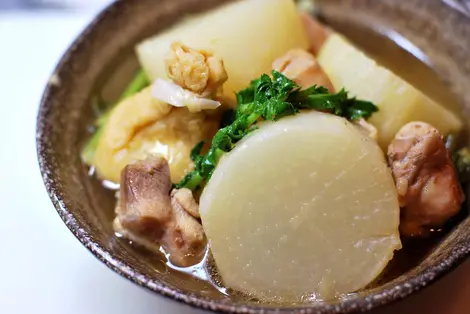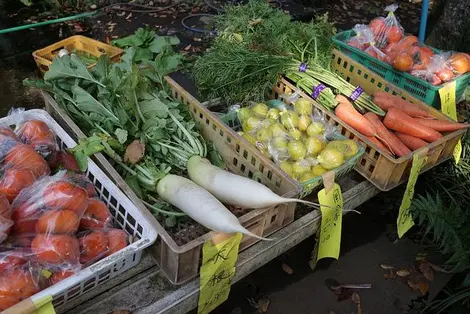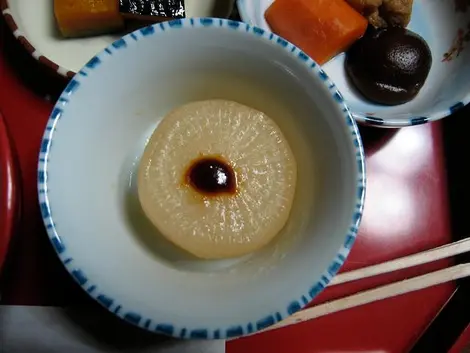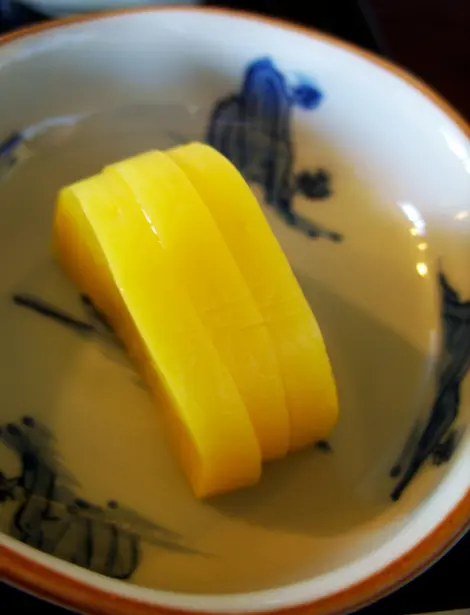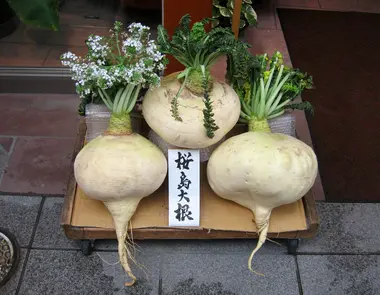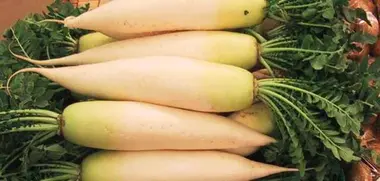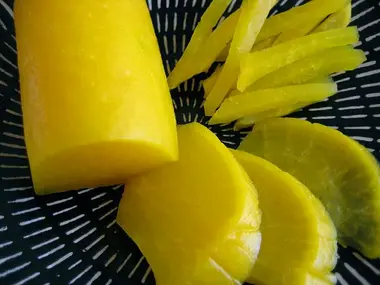Daikon, the Japanese winter radish 大根
The large white radish essential for Japanese cuisine
In Japan, it is quite common to see a pair of vegetables, leeks, and daikon, in a shopping basket at a supermarket.
The large white radish is an essential ingredient for Japanese menus. Cooked in various forms, Japanese daikon radish goes very well with fish and meats or served alone, to appreciate its freshness and crunchiness.
XXL Root With Multiple Virtues
Gaining popularity during the Edo period (1603-1868), this vegetable has become a staple in Japanese kitchens.
Daikon (or Japanese radish) is a large white radish from the cruciferous family that has been cultivated in Japan for around 1300 years . Its name literally means "big root", and for good reason, if it is generally within 30 cm long , some specimens can reach two meters! Despite its size, it has a milder flavor than Western radishes, less pungent, and a crunchy, juicy texture . Low in calories, daikon is rich in vitamin C, fiber and anti-oxidants. The leaves of the radish , rich in vitamins and minerals, are used in traditional Chinese medicine also practiced in Japan.
- Read also: Japanese vegetables
It is possible to eat daikon all year round , the best seasons being autumn and winter, to have a juicy and somewhat sweet flesh. It is slightly spicy in its lower part and softer in its upper part. In summer it is spicier than the rest of the year. White radish is used in Japanese cuisine as a condiment (raw and grated) , in salads, condiments to sauces, or as a cooked vegetable.
- Read also: Autumn specialties in Japan
There were a hundred varieties
In the past, more than a hundred varieties were cultivated across the archipelago, but today its cultivation is reduced to a few regional varieties .
Here are the main ones:
- Aokubi-daikon (literally "green-necked daikon"): it is the most widespread variety in Japan (it represents 95% of the production). Its visible head, at the base of the leaves, takes on a light green color in sunlight. Its taste is sweet and its skin firm (resistant to cooking) and it is very popular. Easy to grow, they can be found all year round.
- Nerima-daikon : produced mainly in the Tokyo area. It is often picked in brine: tsukemono.
- Miura-daikon : It is an improved species of Nerima-daikon cultivated in the Miura peninsula, south of Tokyo. Spicy, it is used as a condiment (raw and grated).
- Moriguchi-daikon : originating in the region of Moriguchi, in the prefecture of Osaka, it is the longest radish in the world (between 1m and 1m50, it can sometimes reach 2 meters! ). Thanks to its spicy taste and firm texture, it is picked in brine with sake.
- Shogoin-daikon: A round radish about 15 cm in diameter and sweet in taste.
Finally, the Sakurajima-daikon :
The volcanic daikon
Sakurajima-daikon is cultivated on the slopes of the Sakurajima volcano, in Kagoshima prefecture, in the extreme south of the island of Kyushu. It is the biggest radish in the world.
- Read also: Stroll on the Sakurajima
With the land around the volcano being unfit for rice cultivation, it is said the locals of the Sakurajima area began to cultivate daikon during the nineteenth century or perhaps even earlier. Due to the beneficial action of the ashes of the volcano (still active) and of the earth, the daikon becomes enormous, very round, while remaining very tasty, very sweet, and low in fiber.
The Sakurajima daikon can reach up to 30 kilos for 50 centimeters in circumference! It is the pride of local farmers and is sold at a high price throughout Japan!
How to eat daikon?
Sheets
Japanese people eat daikon leaves in miso soup, or blanched or cut into small pieces to mix with rice. Formerly called suzushiro, it is one of the plants consumed on the occasion of the feast of the seven herbs.
- Read also: Nanakusa no sekku, the festival of 7 herbs
The root
The root of the daikon can be prepared marinated in tsukemono, such as the takuan with a pronounced taste and yellow appearance. It is also consumed raw in a salad or grated, to accompany sashimi. Its freshness and crunchiness delight the taste buds!
Cut into large pieces in a miso soup, or in a stew with meat or fish, daikon is delicious when cooked and simmered. Try tasting it in the oden stew, ideal for warming up in winter.
- Read also: Oden, the Japanese stew
Grated, it is called daikon oroshi. In this form, daikon is essential to accompany grilled fish, especially sanma (Japanese saury) and mackerel. It also very often accompanies tempura, kara-age-chicken-fried, and the soba-noodles-buckwheat.
From a nutritional perspective, daikon offers many benefits for the digestive system!
Since daikon is produced in large quantities, it is dried for preservation. It is then called kiriboshi-daikon. After grating it, it is dried outside, exposed to the cold all day and overnight. It is then dehydrated (10 kg of white radish produces only 1 kg of kiriboshi-daikon) and it is rehydrated by immersing it in water for 15 minutes before preparation. Dried daikon is rich in vitamins (B1, B2), potassium, fiber (20 times more than fresh white radish) and calcium.
A little vocabulary on the Daikon
Despite the popularity of this vegetable, the idioms in which it is present are hardly flattering. We speak of daikon-ashi as a synonym for "big legs" and, dainkon-yaku as a "bad role" for actors...




